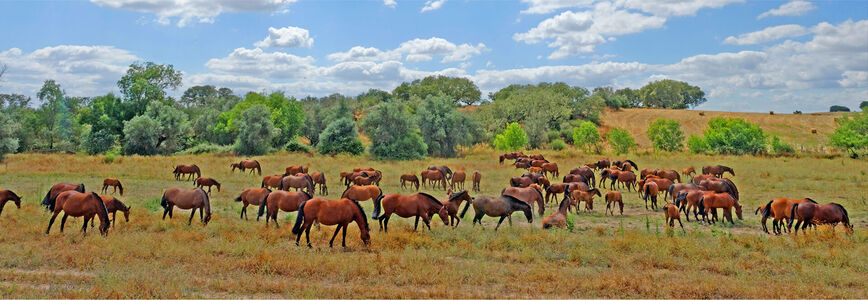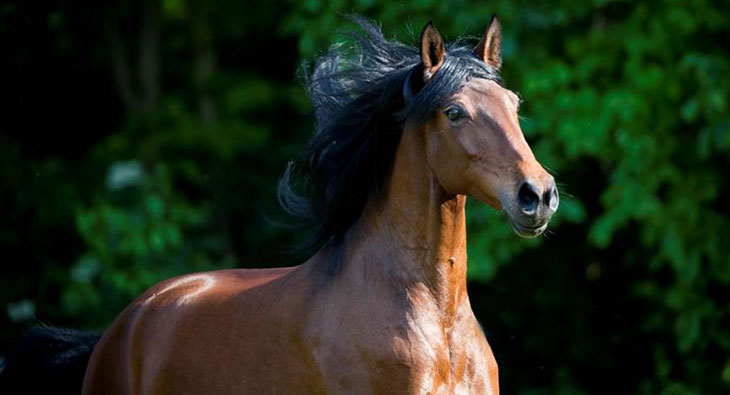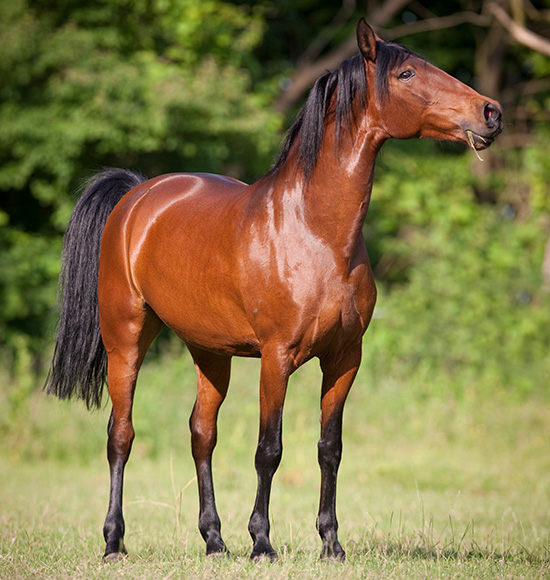
The beautiful horses from Portugal are characterised by their stunning appearance, and they are known to be highly talented and skilled when it comes to advanced dressage.
| Breed: | Alter Real |
| Group: | warmblood |
| Height at the wither: | 150-160 cm |
| Appearance: | square body shape, straight profile with a small head, a lush, wavy mane and deep black tail |
| Colour of coat: | predominantly brown, sometimes chestnut or white |
| Character: | intelligent, eager to learn, with strong nerves, brave, even nature |
| Gait: | expressive, high knee skips, accentuated movements |
| Origin: | Portugal |
| Common in: | Portugal |
| Suited for: | dressage and show riding, leisure time riding |
Did you know? Alter Real horses are almost only common in Portugal. However, in Brazil, thousands of kilometres from Altér do Chão, you will find a horse breed with Portuguese roots: the Mangalarga Marchador. This breed developed at the beginning of the 19th century, when part of the royal Portuguese court fled the invasion of Napoléon and settled in Brazil. The breed was created by crossing the stallion Sublime with Berber and Andalusian mares.

Blue blood: Alter Real horses are of royal descent.
In the 18th century, a very special horse breed emerged from a Portuguese dynasty: Alter Real. In Portuguese, “Real” means “royal”, pointing to the stud's royal descent. “Alter” refers to its geographical origin, because these horses were first bred in Altér do Chão in the southern Portuguese province of Alentejo. Only premium Andalusian mares are used for refining the breed with the aim of creating particularly elegant horses. At the royal court, the horses were used for parades and sports, and they have been especially suited for classical riding disciplines, especially advanced dressage, ever since. In the 19th century, the population of Alter Real horses dropped rapidly, after the majority of the breeding stock was stolen or destroyed. It was only possible to save the population by crossing them with Spanish horses. At the beginning of the 20th century, with the end of the Portuguese monarchy, the breed was almost threatened by extinction again. The fact that Alter Real horses still exist today is due to the private breeder and hippologist Dr. Ruy D´Andrade who saved three Alter Real stallions and 11 mares and continued to breed them. In 1942, the stud of Altér was reopened and the breeding stock was secured. Today, the Portuguese horses are pure-bred. In addition to the studs of Coudelaria Nacional, Veiga and Andrade, the stud of Altér, which is also known as Coudelaria de Altér, is one of the most important breeding lines in Portugal. The stallion Rubi AR is considered the figurehead of the Iberian breed. His spectacular performances at European and World Championships, and even the Olympic Games, made him famous all over the world.

Alter Real horses are considered a thoroughbred line of Lusitano horses.
The Alter Real breed is considered a particularly thoroughbred line of Lusitano horses based on the great similarity and the close bloodline. Alter Real horses can be distinguished by their brown coat and the black mane and tail. Unlike Lusitano horses, they have a rather straight profile and a smaller head. This warmblood, with its square body, the well-positioned, curved neck and the sloping croup, is a typical baroque horse type. Furthermore, there are also similarities to other Iberian horses such as P.R.E. and Andalusian horses.
Both dressage riders and hobby riders appreciate the Alter Real’s even nature. This is due to their great willingness to learn combined with a well-balanced temperament and an intelligent nature with extremely strong nerves. Their elegant appearance and their expressive gaits are just right for dressage, in particular advanced dressage. They are also perfectly suited for the so-called “working equitation”. This is a riding style that originates from working with cattle herds and that has developed into a tournament discipline. In order to be successful in this discipline, a horse must be particularly fast and nimble – which is what breeders have been working on achieving for centuries. The Portuguese warm-blooded horses also give stellar performances in other disciplines such as jumping or horse driving competitions, which proves their versatility.